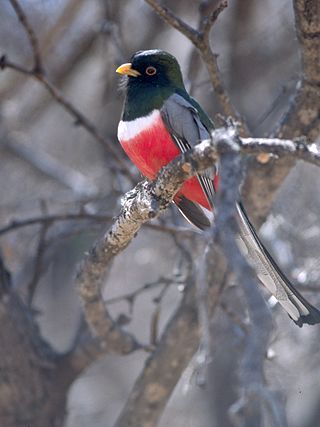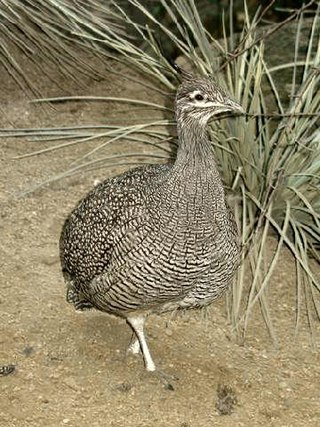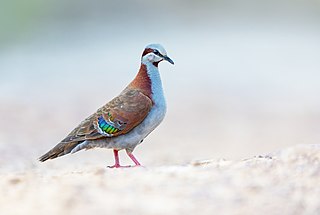
Order Desmothoracida, the desmothoracids, are a group of heliozoan protists, usually sessile and found in freshwater environments. The adult is a spherical cell around 10-20 μm in diameter surrounded by a perforated organic lorica, or shell, with many radial pseudopods projecting through the holes to capture food. These are supported by small bundles of microtubules that arise near a point on the nuclear membrane. Unlike other heliozoans, the microtubules are not in any regular geometric array, there does not appear to be a microtubule organizing center, and there is no distinction between the outer and inner cytoplasm.

Caenorhabditis elegans is a free-living transparent nematode about 1 mm in length that lives in temperate soil environments. It is the type species of its genus. The name is a blend of the Greek caeno- (recent), rhabditis (rod-like) and Latin elegans (elegant). In 1900, Maupas initially named it Rhabditides elegans. Osche placed it in the subgenus Caenorhabditis in 1952, and in 1955, Dougherty raised Caenorhabditis to the status of genus.

The king rail is a waterbird, the largest North American rail.

The crimson rosella is a parrot native to eastern and south eastern Australia which has been introduced to New Zealand and Norfolk Island. It is commonly found in, but not restricted to, mountain forests and gardens. The species as it now stands has subsumed two former separate species, the yellow rosella and the Adelaide rosella. Molecular studies show one of the three red-coloured races, P. e. nigrescens, is genetically more distinct.

The chestnut woodpecker a species of bird in subfamily Picinae of the woodpecker family Picidae. It is found on Trinidad and in every mainland South American country except Argentina, Chile, Paraguay, and Uruguay.

The elegant trogon, previously known as the coppery-tailed trogon, is a near passerine bird in the trogon family native to Central America. The etymology of the word trogon comes from the Greek word trōgein, meaning "to gnaw", which describes how this species prepares its nests in trees.

Elmisaurus is an extinct genus of caenagnathid dinosaur from the Late Cretaceous Nemegt Formation of Mongolia. It was a theropod belonging to the Oviraptorosauria.

The elegant crested tinamou or martineta tinamou is a medium-sized tinamou that can be found in southern Chile and Argentina in Shrubland. The bird has an omnivorous diet. This species is terrestrial due to their poor flying ability.

Oliva is a genus of medium-sized to large sea snails, marine gastropod mollusks in the subfamily Olivinae of the family Olividae, the olive snails or olive shells. Many former species of Oliva have been reclassified under genus Americoliva.

The brush bronzewing is a species of bird in the pigeon family, Columbidae. It is endemic to Australia, with two biogeographically distinct subspecies.

The southern martin is a species of bird in the family Hirundinidae.

The Wyoming ground squirrel is a species of rodent in the family Sciuridae. It is endemic to the Northwestern United States.

The nematodes, roundworms or eelworms constitute the phylum Nematoda. They are a diverse animal phylum inhabiting a broad range of environments. Most species are free-living, feeding on microorganisms, but there are many that are parasitic. The parasitic worms (helminths) are the cause of soil-transmitted helminthiases.
Micropterix elegans is a species of moth belonging to the family Micropterigidae that was described by Stainton in 1867, and is endemic to Israel.

François Émile Maupas was a French librarian, protozoologist, cytologist, and botanist. Maupas contributed to ideas on the life cycle and reproduction of the ciliates. He founded the idea, known as the Maupasian life cycle, that some protists had a definite death following sexual reproduction, contrary to contemporary ideas on protists being immortal. He also identified the existence of mating types in ciliates. He developed culture techniques for a number of organisms and described the nematode Caenorhabditis elegans, which has since become a widely used model organism in biological studies.

Matoniaceae is one of the three families of ferns in the Gleicheniales order of the Polypodiopsida class. Fossil records reveal that Matoniaceae ferns were abundant during the Mesozoic era, during which they lived on every continent, including Antarctica, with eight genera and 26 species, with the oldest known specimens being from the Middle Triassic of Antarctica. Today the family is much less abundant, and also less diverse, with only two extant genera and four species, which are limited to portions of southeastern Asia.

Ceropales is a genus of kleptoparasitic spider wasps from the sub-family Ceropalinae of the family Pompilidae. They are characterised by the taking of the spider prey of other solitary wasps, mainly Pompilidae but members of the Sphecidae that provision with spider prey are sometimes also hosts. In some languages their name translates into English as "cuckoo spider wasp".

Myoxocephalus brandtii, the snowy sculpin, is a species of marine ray-finned fish belonging to the family Cottidae, the typical sculpins. This species is found in the northwest Pacific, with a range extending from the Sea of Okhotsk to Hokkaido and the Sea of Japan.

Granofilosea is a class of cercozoan protists in the subphylum Reticulofilosa. Out of the three groups that were traditionally considered heliozoans: the heliomonads, gymnosphaerids and desmothoracids, the latter were recently grouped into this new class.
Sara Gwendolen Foulke was an American zoologist, marine biologist and poet. She worked on microscopic water inhabiting animals and her obituary described her work as "genius."

















